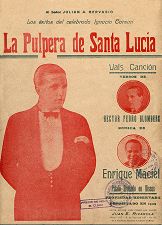By
La pulpera de Santa Lucía - Ignacio Corsini, the one who saved La Pulpera...

hose three artists who cultivated popular song and whose careers reached wide and deserved acclaim until becoming idols (Carlos Gardel, Agustín Magaldi and Ignacio Corsini), invariably had in their repertories, one or several tunes which, by means of their fitting interpretation, turned out to be true popular hits.
 The lists of renditions by these three singers, chosen as reference because they reached the people's heart and their memory is still in force in it, abound in compositions of better quality, either musical or literary, but the public pointed out, maybe more through sentiment rather than through brain, specific works that, when we name them, are immediately identified with their interpreters instead of their authors.
The lists of renditions by these three singers, chosen as reference because they reached the people's heart and their memory is still in force in it, abound in compositions of better quality, either musical or literary, but the public pointed out, maybe more through sentiment rather than through brain, specific works that, when we name them, are immediately identified with their interpreters instead of their authors.
In Gardel's case, we could talk of “Tomo y obligo” or of “Mano a mano” as his favorite numbers, which he permanently included in nearly all his public presentations (not taking into account the widely known songs of his movies); in Magaldi's case, the unquestionable one is “El penado catorce”, and in Corsini's, at the time of writing these lines I am hesitating between two: “Patotero sentimental” and “La pulpera de Santa Lucía”. And in my opinion, very personal indeed, I think that the waltz is much more recognized than the tango by Manuel Jovés and Manuel Romero.
Furthermore, it has more importance, because with “La pulpera de Santa Lucía” the first collaboration between its creators took place. The musician Enrique Maciel (1897-1962) and the poet Héctor Blomberg (1890-1955) got to know one another in 1928, the year the immortal composition was born.
 Andrés Chinarro states that they were introduced (Atlántida magazine, November 1957) «during a ball organized by the Club de la Bolsa de Comercio (Chamber of Commerce Club), where Maciel was performing, and it was due to a friend in common, José Antonio Gervasio, who went to one of the mentioned evening reunions at the old Luna Park (famous boxing stadium in the city of Buenos Aires), on 100 Corrientes Avenue, accompanied by Blomberg. The latter (according to Maciel's memory) handed him his first lyric: “La pulpera de Santa Lucía”».
Andrés Chinarro states that they were introduced (Atlántida magazine, November 1957) «during a ball organized by the Club de la Bolsa de Comercio (Chamber of Commerce Club), where Maciel was performing, and it was due to a friend in common, José Antonio Gervasio, who went to one of the mentioned evening reunions at the old Luna Park (famous boxing stadium in the city of Buenos Aires), on 100 Corrientes Avenue, accompanied by Blomberg. The latter (according to Maciel's memory) handed him his first lyric: “La pulpera de Santa Lucía”».
That first collaboration helped to start a perfect association between them, through which a numerous group of songs of historical-evocative character about neighborhoods and persons of Buenos Aires at the time of Rosas was devised: “La canción de Amalia”, “La mazorquera de Monserrat”, “Rosa morena”, “La guitarrera de San Nicolás”, “Los jazmines de San Ignacio” and some more, are examples of that impeccable poetic-musical framework that Blomberg and Maciel achieved, and which was inaugurated with “La pulpera de Santa Lucía”. Although the team, outside this subject matter, produced other long lasting numbers: “El adiós de Gabino Ezeiza”, “La viajera perdida”, “Violines gitanos” and the anthological tango “La que murió en París”.
However, although it seems to be a lie, the waltz “La pulpera de Santa Lucía” was rejected by the theater entrepreneur Pascual Carcavallo and his musical advisor. The famous tango “Nostalgias” was as well rejected at its time by another theater impresario, don Alberto Ballerini.
But then Ignacio Corsini appeared, who premiered it on Radio Prieto, he committed it to record in April 1929 and so he immortalized that waltz.
That is why we said in the heading lines that The gentleman-singer was the one who «saved La pulpera...» (a woman keeping a general store).
As a testimony we have an interview to Enrique Maciel made by the journalist Andrés Muñoz in 1948, published in the magazine Aquí está. We owe this valuable testimony to our colleague Orlando Del Greco, who made it available to us through his magazine Tango. La mejor música del mundo, Nº 34, January 1999.
 «On Blomberg's lyrics —says Maciel— I composed the music after having rejected several ones which did not satisfy my requirements. Under such circumstances the actor Sarcione informed the impresario Pascual Carcavallo about a song that could perfectly fit into Reta and Viale Paz's play, La sangre de las guitarras. I was requested to go to the teatro Nacional where I myself sang the song, accompanying myself on piano in front of the mentioned impresario, the actress Elsa O'Connor and the maestros Salvador Merico and José Lozzi, conductor and concert master, respectively, of the theater orchestra. As Lozzi's opinion (unfavorable for my music) prevailed, “La pulpera de Santa Lucía” was sent to the archives.
«On Blomberg's lyrics —says Maciel— I composed the music after having rejected several ones which did not satisfy my requirements. Under such circumstances the actor Sarcione informed the impresario Pascual Carcavallo about a song that could perfectly fit into Reta and Viale Paz's play, La sangre de las guitarras. I was requested to go to the teatro Nacional where I myself sang the song, accompanying myself on piano in front of the mentioned impresario, the actress Elsa O'Connor and the maestros Salvador Merico and José Lozzi, conductor and concert master, respectively, of the theater orchestra. As Lozzi's opinion (unfavorable for my music) prevailed, “La pulpera de Santa Lucía” was sent to the archives.
«That resulted in my first disappointment. But fate made Ignacio Corsini get in my way, who premiered it on a radio station, with an unexpected success, even for me, so much so that it happened that the audience asked for encores by telephone, by mail or even personally.
«To be truthful, I must admit that Corsini sang it very well. Five hundred thousand copies were launched for sale and a hundred and fifty seven thousand records were released, all of which meant for me as copyright royalties, the then fabulous sum of twenty thousand pesos... And when the boom was already unarguable and there was neither female or male singer, nor boy with dreams to become one, nor inhabitant of any sex or age who omitted singing or whistling La pulpera..., Pascual Carcavallo got in my way once more, and told me: "I was wrong with you once, but I won't be again"».
Although the figures given by Maciel concerning the sale of copies and records may seem exaggerated, no one will deny the popularity and perdurance of “La pulpera de Santa Lucía”, thanks to the fact that it was «saved» by Ignacio Corsini.
Originally published in the magazine Tango y lunfardo, Nº 151, Chivilcoy, 16 April 1999.